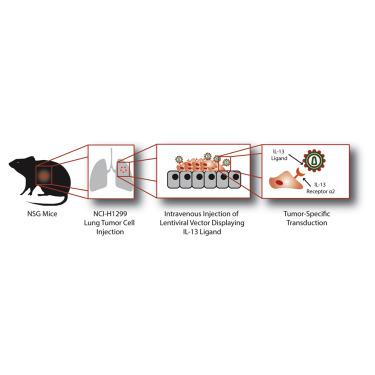Molecular Therapy - Methods & Clinical Development ( IF 4.6 ) Pub Date : 2021-04-24 , DOI: 10.1016/j.omtm.2021.04.012 Takele Argaw 1 , Michael P Marino 1 , Andrew Timmons 1 , Lindsey Eldridge 1 , Kazuyo Takeda 2 , Pingjuan Li 1, 3 , Anna Kwilas 1 , Wu Ou 1 , Jakob Reiser 1

|
Despite their exceptional capacity for transgene delivery ex vivo, lentiviral (LV) vectors have been slow to demonstrate clinical utility in the context of in vivo applications. Unresolved safety concerns related to broad LV vector tropism have limited LV vectors to ex vivo applications. Here, we report on a novel LV vector-pseudotyping strategy involving envelope glycoproteins of Tupaia paramyxovirus (TPMV) engineered to specifically target human cell-surface receptors. LV vectors pseudotyped with the TPMV hemagglutinin (H) protein bearing the interleukin (IL)-13 ligand in concert with the TPMV fusion (F) protein allowed efficient transduction of cells expressing the human IL-13 receptor alpha 2 (IL-13Rα2). Immunodeficient mice bearing orthotopically implanted human IL-13Rα2 expressing NCI-H1299 non-small cell lung cancer cells were injected intravenously with a single dose of LV vector pseudotyped with the TPMV H-IL-13 glycoprotein. Vector biodistribution was monitored using bioluminescence imaging of firefly luciferase transgene expression, revealing specific transduction of tumor tissue. A quantitative droplet digital PCR (ddPCR) analysis of lung tissue samples revealed a >15-fold increase in the tumor transduction in mice treated with LV vectors displaying IL-13 relative to those without IL-13. Our results show that TPMV envelope glycoproteins can be equipped with ligands to develop targeted LV vectors for in vivo applications.
中文翻译:

用带有细胞特异性配体的副猪嗜血小粘病毒H糖蛋白假型化的慢病毒载体的体内靶向
尽管它们具有离体转基因递送的出色能力,但慢病毒(LV)载体在体内应用的背景下显示临床应用的速度很慢。与广泛的LV载体向性相关的未解决的安全问题将LV载体限制在离体范围内应用程序。在这里,我们报道了一种新型的LV载体假型化策略,该策略涉及被专门针对人细胞表面受体而设计的Tupaia副粘病毒(TPMV)的包膜糖蛋白。用带有白介素(IL)-13配体的TPMV血凝素(H)蛋白与TPMV融合(F)蛋白一起假型化的LV载体可以有效地转导表达人IL-13受体α2(IL-13Rα2)的细胞。向携带原位植入的表达人IL-13Rα2的表达NCI-H1299非小细胞肺癌细胞的免疫缺陷小鼠静脉内注射单剂量的TPMV H-IL-13糖蛋白假型的LV载体。使用萤火虫荧光素酶转基因表达的生物发光成像监测载体的生物分布,揭示肿瘤组织的特异性转导。肺组织样品的定量液滴数字PCR(ddPCR)分析显示,与没有IL-13的小鼠相比,用具有IL-13的LV载体治疗的小鼠的肿瘤转导增加了15倍以上。我们的结果表明,TPMV包膜糖蛋白可配备配体以开发针对性的LV载体体内应用。















































 京公网安备 11010802027423号
京公网安备 11010802027423号